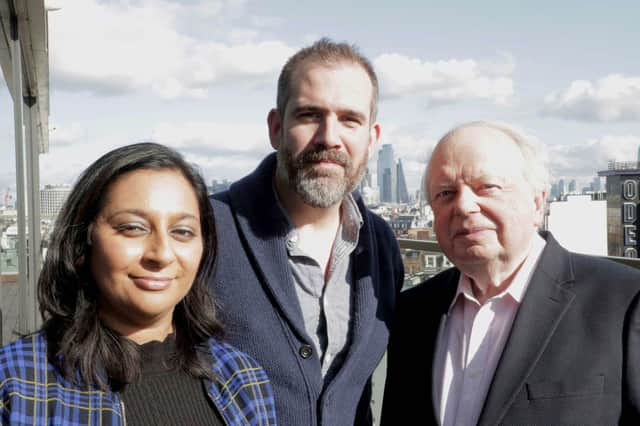‘Lockdown’ was used during the Great Plague


Britain 355 years ago was not so dissimilar to today.
However, as medic Xand van Tulleken, archaeologist Raksha Dave and journalist John Sergeant explain over the next three evenings, having to queue in the supermarket for a pack of toilet roll or bag of pasta is nothing compared to the hardships faced by the public the last time the country faced a catastrophic epidemic.
Advertisement
Hide AdAdvertisement
Hide AdIn the sweltering summer of 1665, the bubonic plague, a disease with no cure, came to London.
At its peak in September that year, it killed 100,000 in London (25 per cent of the city’s population), and a further 100,000 in the rest of the country.
However, these figures are almost certainly an underestimate –many victims were simply not recorded.
As Xand, Raksha and John trace its tragic and rapid spread, week by week, they discover some extraordinary parallels between the 17th-century epidemic and the current pandemic, including how a form of ‘lockdown’ was used during the Great Plague, how cleaning methods in the 1660s may have been as effective as modern antibacterial sprays, and what Londoners used centuries before PPE was invented.
Advertisement
Hide AdAdvertisement
Hide AdIn tonight’s opening episode, the trio trace the epidemic back to its source in the parish of St Giles in the Fields, now at the heart of London’s theatreland.
Xand tracks the disease as it took hold in the slum areas of the capital in the spring of 1665.
Meanwhile, Raksha heads to the top-secret labs at Porton Down where she sees the deadly bacteria responsible for the Great Plague, yersinia pestis.
She also travels to Marseille to investigate astonishing new research that overturns the long-held belief that rats and their fleas were responsible for spreading the Great Plague.
Advertisement
Hide AdAdvertisement
Hide AdFinally, John reveals the symptoms of bubonic plague, and learns that the disease gets its name from the swollen lumps or ‘buboes’ that were its most obvious indicator.
He also explores the impoverished living conditions of the time and discovers how these helped to spread the plague.
In tomorrow’s second edition, Xand heads to St Bartholomew’s Hospital where he discovers that while many doctors fled the outbreak, nursing staff stayed behind, risking their lives to help the sick.
He also finds historical echoes of the social-distancing methods used to control Covid-19 in the emergency orders issued by the Lord Mayor of London.
Advertisement
Hide AdAdvertisement
Hide AdIn 1665, infected families were ‘shut-up’ in their homes and their doors marked with red crosses.
In shops, coins were placed in vinegar to avoid physical contact.
Raksha discovers that the hideous beaked ‘plague doctor’ outfit was an effective form of 17th-century PPE but reveals that there is actually no evidence it was ever worn in the UK.
Finally, in Thursday’s third instalment, Xand visits diarist Samuel Pepys’ parish church and discovers the sad tale of the Poole family who lost all five of their children within 11 days.
Advertisement
Hide AdAdvertisement
Hide AdHe also heads to Eyam in Derbyshire, revealing the heroic story of self-sacrifice that saw 700 villagers lock themselves in to stop the disease spreading to surrounding towns.
Raksha trials 17th-century disinfection methods and shows that whitewash can be as effective against bacteria as modern anti- bacterial cleaners.
After watching these programmes, some viewers may wonder if we can learn a few things from the people of 1665 when tackling our current pandemic.
But bearing in mind the 17th-century plague didn’t really end until the Great Fire of London, we should take any historical lessons with a pinch of salt.
A message from the Editor:
Advertisement
Hide AdAdvertisement
Hide AdThank you for reading this story on our website. While I have your attention, I also have an important request to make of you.
In order for us to continue to provide high quality and trusted local news on this free-to-read site, I am asking you to also please purchase a copy of our newspaper whenever you are able to do so.
Our journalists are highly trained and our content is independently regulated by IPSO to some of the most rigorous standards in the world. But being your eyes and ears comes at a price. So we need your support more than ever to buy our newspapers during this crisis.
With the coronavirus lockdown having a major impact on many of our local valued advertisers - and consequently the advertising that we receive - we are more reliant than ever on you helping us to provide you with news and information by buying a copy of our newspaper when you can safely.
Advertisement
Hide AdAdvertisement
Hide AdYou can also enjoy unlimited access to the best news from across Northern Ireland and the UK by subscribing to newsletter.co.uk
With a digital subscription, you can read more than five articles, see fewer ads, enjoy faster load times, and get access to exclusive newsletters and content. Visit https://www.newsletter.co.uk/subscriptions now to sign up.
Thank you